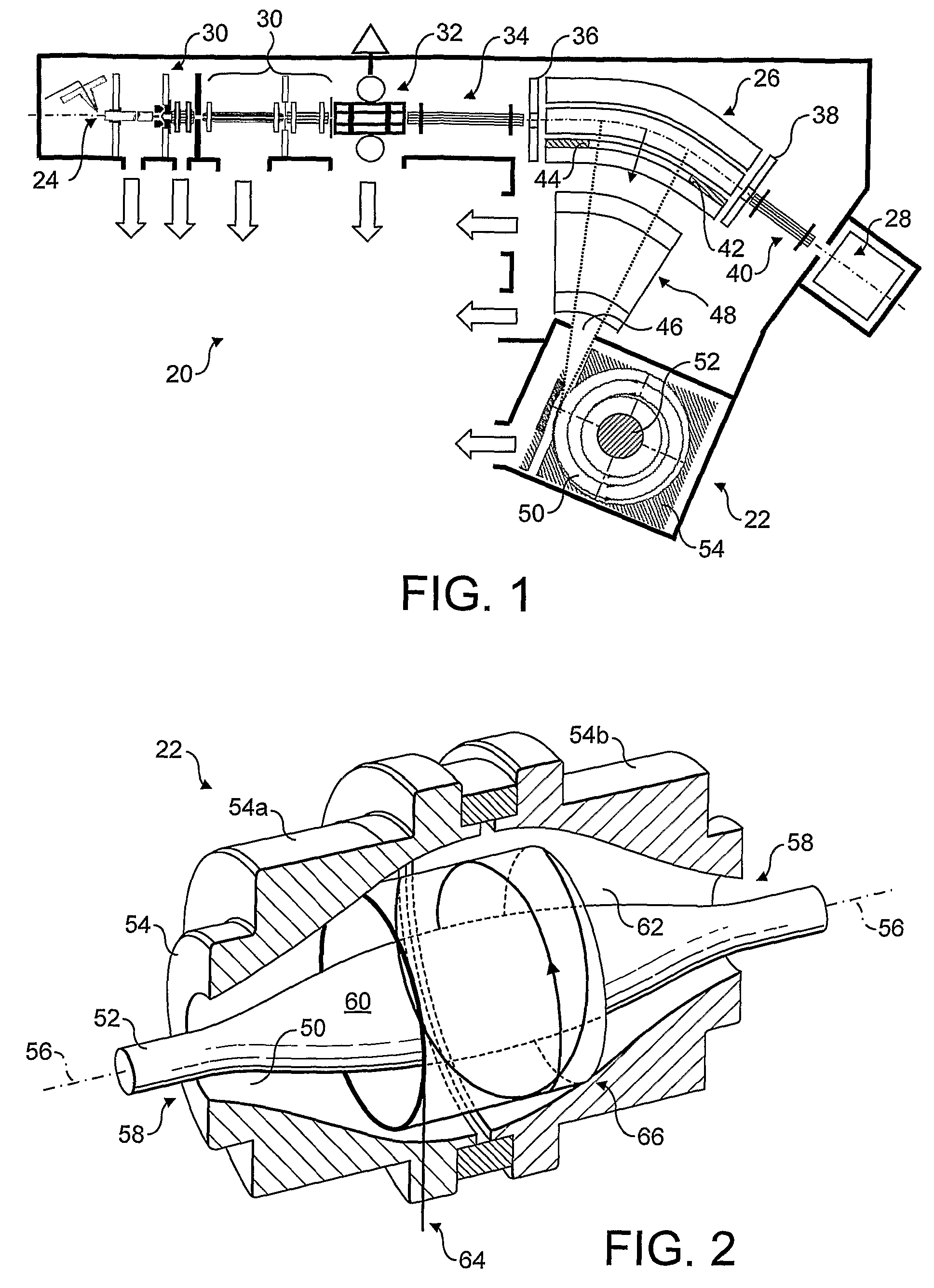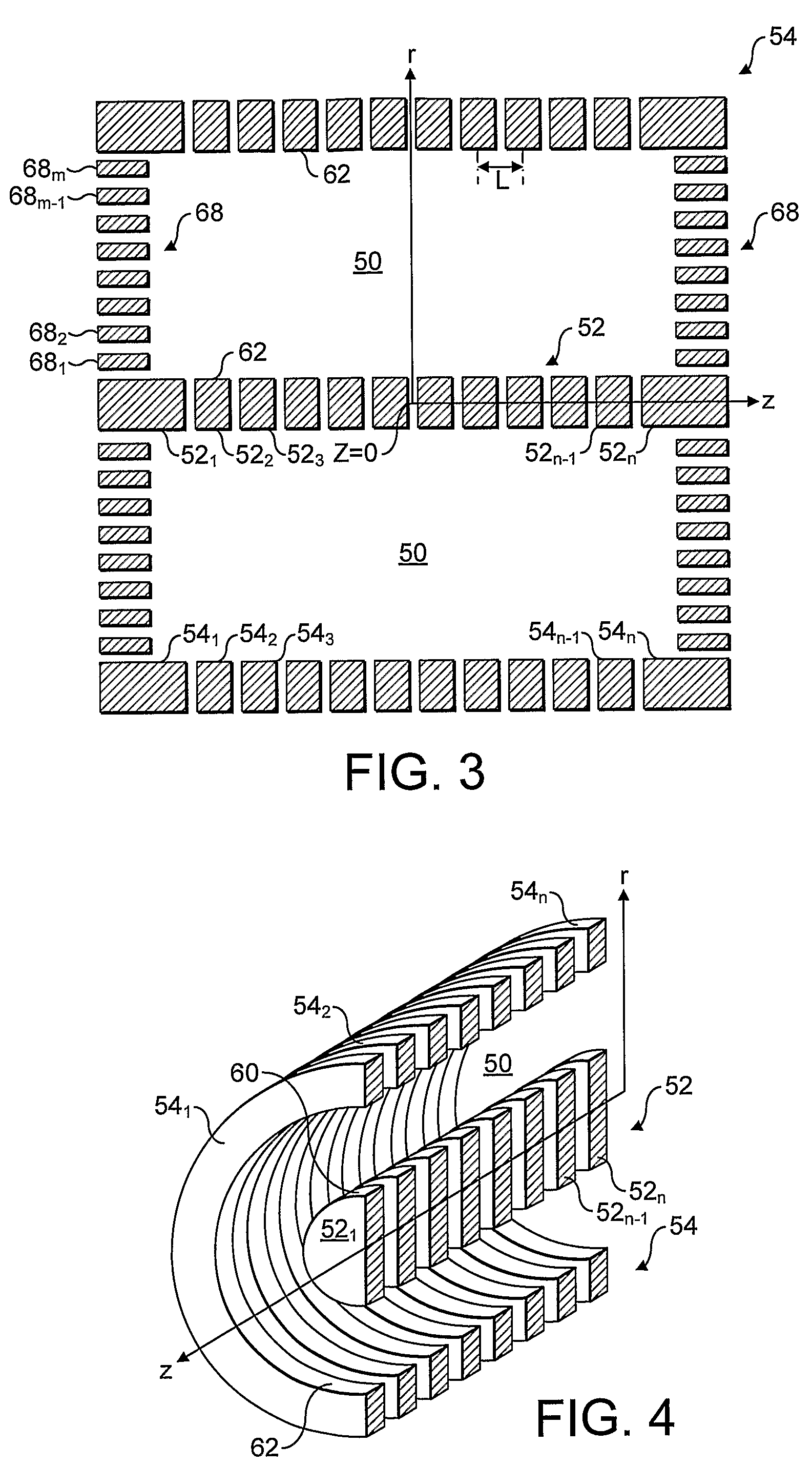Multi-electrode ion trap
a technology of electrostatic ion traps and electrodes, applied in the direction of tube electrostatic deflection, particle separator tube details, separation process, etc., can solve the problems of increasing the difficulty of achieving the required performance level, increasing the difficulty of mass production of electrode shapes to such an exacting tolerance, and increasing the difficulty of achieving the required level of performance. , to achieve the effect of improving the maintenance of isochronicity or coherence, improving the voltage, and improving the peak shap
- Summary
- Abstract
- Description
- Claims
- Application Information
AI Technical Summary
Benefits of technology
Problems solved by technology
Method used
Image
Examples
first embodiment
[0056]FIG. 3 corresponds to a cross-section taken along the z axis of the electrodes 52, 54 and 68 of an Orbitrap mass analyser 22 according to the present invention, and FIG. 4 shows the inner and outer electrodes 52 and 54 in perspective. In contrast to FIG. 2, the outer electrode 54 defines a cylindrical shape. The ends of the trapping volume 50 are closed by end electrodes 68 (shown only in FIG. 3), rather than being open as in FIG. 2. The inner electrode 52 is also cylindrical. Inner and outer electrodes 52 and 54 remain coaxial with the z axis.
[0057]The electrostatic mass analyser 22 of FIGS. 3 and 4 uses a quite different approach to generate the desired hyper-logarithmic field. The inner and outer electrodes 52 and 54 of FIG. 2 are shaped such that their respective outer and inner surfaces 60 and 62 follow equipotentials, thereby allowing almost the same voltage to be applied to each of the inner electrode 52 and outer electrode 54. This favoured approach of perfecting elect...
second embodiment
[0084]FIG. 8 shows the electrode structure of an Orbitrap mass analyser 22 according to the present invention. In this embodiment, there are no end electrodes 68 such that the trapping volume 50 is open at either end 58. While the inner and outer electrodes 52 and 54 still comprise sets of ring electrodes 521 . . . n and 541 . . . n, their outer and inner surfaces 60 and 62 respectively are no longer level to define cylindrical edges. Instead, the respective outer and inner surfaces 60 and 62 are staggered so as to follow approximately an equipotential of the desired hyper-logarithmic field.
[0085]Voltages may be applied to the ring electrodes 521 . . . n and 541 . . . n under computer control. As the ring electrodes 521 . . . n and 541 . . . n generally follow equipotentials, the individual voltages applied to each ring electrode 521 . . . n and 541 . . . n will be approximately equal. Thus, smaller voltages can be generated across the resistive networks 70 such that more accurate, ...
third embodiment
[0087]FIG. 9 shows an electrode arrangement in a mass analyser 22 according to the present invention. The embodiment corresponds broadly to that of FIGS. 3 and 4, except the inner electrode 52 is now formed by a single-piece electrode akin to that of the prior art of FIG. 2. It may be advantageous to use a single piece inner electrode 52 in terms of manufacturing: it is very much easier to grind or turn this inner electrode 52 as a single piece. Provision of the many ring electrodes 541 . . . n and 681 . . . m for the outer electrode 54 and end electrodes 68 means that computer control may still be used to optimise the trapping field, including correcting any inaccuracies in the shape of the inner electrode 52.
PUM
 Login to View More
Login to View More Abstract
Description
Claims
Application Information
 Login to View More
Login to View More - R&D
- Intellectual Property
- Life Sciences
- Materials
- Tech Scout
- Unparalleled Data Quality
- Higher Quality Content
- 60% Fewer Hallucinations
Browse by: Latest US Patents, China's latest patents, Technical Efficacy Thesaurus, Application Domain, Technology Topic, Popular Technical Reports.
© 2025 PatSnap. All rights reserved.Legal|Privacy policy|Modern Slavery Act Transparency Statement|Sitemap|About US| Contact US: help@patsnap.com



